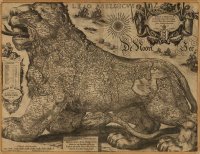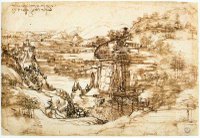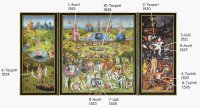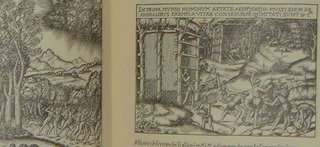Wednesday, May 23, 2007
Thursday, September 21, 2006
Thursday, August 31, 2006
(7) Jodocus Hondius and Mercator


A version of Mercator's map of a round São Tomé Island by the same Jodocus Hondius who published the map of Leo Belgicus (below) was published as late as 1625.
The island is actually not round.
(sources of maps)

(6) Leonardo and Leo Belgicus (part two)

The Allegorical Theme: Combat of Animals attributed to the Master of the Beheading of St. John the Baptist is not just based on the two Leonardo drawings shown in the previous post, but also on maps of the Netherlands in the form of Leo Belgicus, the Belgian lion, and probably on the version by Jodocus Hondius shown here.

 My guess is that the The Allegorical Theme: Combat of Animals and the print of The Beheading of John the Baptist were probably published by Hendrick Hondius, who published the engraved portrait of Hieronymus Bosch at the right in the illustration below. It is well known that the engraving was based on a colored drawing of Hieronymus Bosch in an old album, and it has never been noticed that the engraving made him look a little more like the Mona Lisa. The jokes of Hendrick Hondius are sometimes complicated, and the one in the The Allegorical Theme: Combat of Animals has to do with
My guess is that the The Allegorical Theme: Combat of Animals and the print of The Beheading of John the Baptist were probably published by Hendrick Hondius, who published the engraved portrait of Hieronymus Bosch at the right in the illustration below. It is well known that the engraving was based on a colored drawing of Hieronymus Bosch in an old album, and it has never been noticed that the engraving made him look a little more like the Mona Lisa. The jokes of Hendrick Hondius are sometimes complicated, and the one in the The Allegorical Theme: Combat of Animals has to do with1) Leonardo da Vinci and Leo Belgicus, both lions, i.e. both catsBased on subtle similarities to Rembrandt prints in a few places and other Hondius prints, the date of the Allegorical Theme: Combat of Animals might be in the mid-1640s.
2) two cartographers and publishers of maps, Hendrick Hondius (who also published the edition of Lampsonius with the Bosch portrait) and another person named and doing business as Hendrick Hondius who published more maps, and larger maps. Hondius is Latin for hondt, i.e. a dog. The Hondius who published the Bosch portrait also published a series of maps of 's-Hertogenbosch, the city where Hieronymus Bosch lived and after which he named himself.
(Details will be added in a note; also there will be more on cats and dogs above.)

Wednesday, August 30, 2006
(5) Leonardo and Leo Belgicus (part one)
 The engraving shown here is listed as Allegorical Theme: Combat of Animals, c. 1515-20, attributed to the Master of the Beheading of John the Baptist, and has been thought to be based on two drawings by Leonardo da Vinci, shown below. The Master of the Beheading of John the Baptist is only known for a print of that subject, the print shown here, and some small prints.
The engraving shown here is listed as Allegorical Theme: Combat of Animals, c. 1515-20, attributed to the Master of the Beheading of John the Baptist, and has been thought to be based on two drawings by Leonardo da Vinci, shown below. The Master of the Beheading of John the Baptist is only known for a print of that subject, the print shown here, and some small prints.The Allegorical Theme: Combat of Animals appears to be based not just on the Leonardo drawings, but also on Bruegel prints with buildings in the distance drawn the same way. In some places the style of printing and engraving resembles prints by Rembrandt. This print is a joke.
(Details on catalogues, locations, etc. will be added later.)


Sunday, July 09, 2006
(4) The Pedlar
 The Pedlar is most likely not by Hieronymus Bosch if it is based on a picture in the Dresden Codex. This means that my own previously published article on it is incorrect and incomplete ("The Good Thief imagined as a peddler," in Source 17:2 (1998), p. 4-14). Other paintings on wood from the same tree according to the recent dendrochronological studies might either be copies of paintings by Hieronymus Bosch, or new images, like The Pedlar.
The Pedlar is most likely not by Hieronymus Bosch if it is based on a picture in the Dresden Codex. This means that my own previously published article on it is incorrect and incomplete ("The Good Thief imagined as a peddler," in Source 17:2 (1998), p. 4-14). Other paintings on wood from the same tree according to the recent dendrochronological studies might either be copies of paintings by Hieronymus Bosch, or new images, like The Pedlar.
(3) The Prints of Hieronymus Bosch
 This blog is a continuation of The Prints of Hieronymus Bosch, published in 2002. In the book a few prints were still attributed to the architect Alart du Hameel, but it now seems more likely that Alart du Hameel was not the author of any prints.
This blog is a continuation of The Prints of Hieronymus Bosch, published in 2002. In the book a few prints were still attributed to the architect Alart du Hameel, but it now seems more likely that Alart du Hameel was not the author of any prints.
(2) West Indies Landscape
 The West Indies Landscape, usually attributed to Jan Mostaert, is more likely from the seventeenth century, most likely from c. 1642 and painted to mark the 150th anniversary of Columbus's first landing. It portrays the Dutch and English adventures in New Netherlands and New England in a negative light.
The West Indies Landscape, usually attributed to Jan Mostaert, is more likely from the seventeenth century, most likely from c. 1642 and painted to mark the 150th anniversary of Columbus's first landing. It portrays the Dutch and English adventures in New Netherlands and New England in a negative light.It is true that it is based on a description by Karel van Mander of a lost Mostaert painting, but it appears to have been painted after Van Mander's death as an hommage, to call attention to his having translated Girolamo Benzoni's History of the New World.
(1) Garden of Delights/Jardín de las Delicias

 The Garden of Delights/El Jardín de las Delicias cannot be by Hieronymus Bosch (d. 1516) since it includes a Nahuatl chronology from 1519 to 1528. It is not a copy either, since the dates are too large to have been added without making extensive changes to the composition.
The Garden of Delights/El Jardín de las Delicias cannot be by Hieronymus Bosch (d. 1516) since it includes a Nahuatl chronology from 1519 to 1528. It is not a copy either, since the dates are too large to have been added without making extensive changes to the composition.


